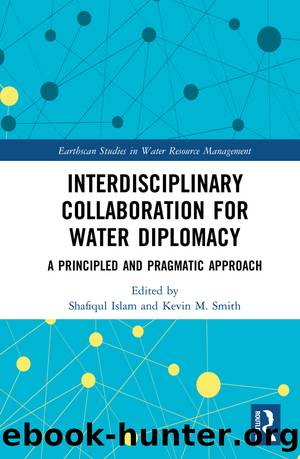Interdisciplinary Collaboration for Water Diplomacy: A Principled and Pragmatic Approach by Shafiqul Islam & Kevin M Smith

Author:Shafiqul Islam & Kevin M Smith [Islam, Shafiqul & Smith, Kevin M]
Language: eng
Format: epub
ISBN: 9781032084893
Google: SEFmzgEACAAJ
Goodreads: 57868377
Publisher: Routledge
Published: 2021-06-30T10:13:36+00:00
Collective-choice arrangements
Criteria: When multiple users are dependent on the same resource for economic activity, the well-being of individuals is tightly interconnected to the actions of others in the same resource system (Bleed and Babbitt 2015). The basic problem they face is in organizing a governance system to avoid allowing individual water users to act independently of each other and in creating a system in which they adopt coordinated strategies to achieve higher collective benefits and/or reduce collective harm (Ostrom 1990; Bleed and Babbitt 2015). In other words, the collective-choice criterion is thought to represent the key to reducing the likelihood that water governance will lead to a âtragedy of the commons.â To achieve collective choice, most individuals affected by governance rules should be included in the group who can modify them (Ostrom 1990). This does not mean that legally authorized decision makers must yield authority to the collaborating group; rather, stakeholders must have an active role in joint problem solving, formulating alternatives, and ranking preferred solutions (Bruns 2003; Bleed and Babbitt 2015).
This design principle appears to be strongest in Nebraska because the institutional structure of the NRDs encourages collective-choice arrangements, and the NRDs have broad regulatory and enforcement authority. Any citizen of an NRD may run for director or for the board, and the members, who make the rules, are part of the local community and must follow the rules themselves (Bleed and Babbitt 2015; personal interviews). In effect, those governed by the rules are able to participate directly in developing and modifying the rules by serving on the board and indirectly through the public meeting process of the NRD boards, where stakeholders can provide input as rules are created or modified.
While the Kansas GMDs were created with local management and stake-holder participation in mind, in practice this participation is narrowly drawn (Peck 2006). Peck (2006) points out that the GMD boards of directors are made up primarily of irrigators, landowners, and other water users and that few positions on the boards are reserved for other stakeholders, such as municipal interests, environmental interests, or businesses that do not use large quantities of water or hold water rights, or for the public at large. The boards are locally elected, but the KGMDA defines an eligible voter narrowly as an adult person or corporation, municipality, or any other legal or commercial entity that: (1) owns 16.2 ha (40 acres) of land within a GMD and not within the corporate limits of any municipality, and (2) that withdraws at least 1,233 m3 (1 acre-foot) of groundwater from within the GMD annually (Kan Stat. Ann. §82a-1021 2017). This definition of an eligible voter excludes the participation of all stakeholders who are affected by the rules and is problematic for this design principle. Additionally, while the GMDs are local institutions, they have limited authority to make and modify the rules regarding ground-water allocation and regulation because the state has primary authority. Thus, we argue that Kansas does not meet this design principle.
Local control is central
Download
This site does not store any files on its server. We only index and link to content provided by other sites. Please contact the content providers to delete copyright contents if any and email us, we'll remove relevant links or contents immediately.
| Automotive | Engineering |
| Transportation |
Whiskies Galore by Ian Buxton(41625)
Introduction to Aircraft Design (Cambridge Aerospace Series) by John P. Fielding(32954)
Small Unmanned Fixed-wing Aircraft Design by Andrew J. Keane Andras Sobester James P. Scanlan & András Sóbester & James P. Scanlan(32625)
Craft Beer for the Homebrewer by Michael Agnew(18008)
Turbulence by E. J. Noyes(7810)
The Complete Stick Figure Physics Tutorials by Allen Sarah(7201)
Kaplan MCAT General Chemistry Review by Kaplan(6711)
The Thirst by Nesbo Jo(6602)
Bad Blood by John Carreyrou(6379)
Modelling of Convective Heat and Mass Transfer in Rotating Flows by Igor V. Shevchuk(6284)
Learning SQL by Alan Beaulieu(6097)
Weapons of Math Destruction by Cathy O'Neil(5968)
Man-made Catastrophes and Risk Information Concealment by Dmitry Chernov & Didier Sornette(5775)
Digital Minimalism by Cal Newport;(5495)
Life 3.0: Being Human in the Age of Artificial Intelligence by Tegmark Max(5285)
iGen by Jean M. Twenge(5237)
Secrets of Antigravity Propulsion: Tesla, UFOs, and Classified Aerospace Technology by Ph.D. Paul A. Laviolette(5153)
Design of Trajectory Optimization Approach for Space Maneuver Vehicle Skip Entry Problems by Runqi Chai & Al Savvaris & Antonios Tsourdos & Senchun Chai(4899)
Electronic Devices & Circuits by Jacob Millman & Christos C. Halkias(4806)
